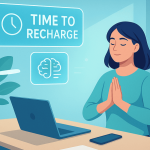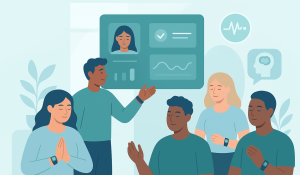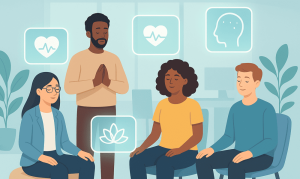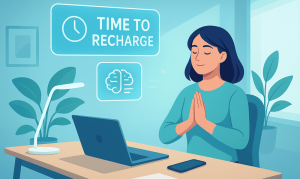The link between physical and mental health has always been clear, but for many employees, the workday disconnects the two. Long hours, back-to-back meetings, and constant digital pressure create both physical strain and mental fatigue.
Today, AI mind-body workplace wellness tools are changing that. They help employees understand their personal health data, monitor stress, and receive timely wellbeing nudges—all without adding extra effort to their day.
This integration of AI with wearables and coaching builds a work culture where wellbeing isn’t just a policy—it’s part of everyday behavior.
How AI Bridges the Mind-Body Gap
AI wellness technology doesn’t just track metrics—it interprets them. By combining signals from smart devices, mental health apps, and work habits, AI provides insights that lead to measurable improvements in both focus and physical health.
For instance, wearable wellbeing tracking now includes not only step counts or heart rate, but also stress variability, sleep rhythm, and recovery quality. These real-time readings feed into holistic wellness AI platforms that suggest small, practical actions—like a 3-minute breathing exercise before a presentation or a posture reminder during long calls.
When paired with AI mindfulness tools, employees receive micro-coaching moments that build resilience throughout the day.
The Role of Wearables in Workplace Wellness
Wearables have become a silent wellness partner for many professionals. Fitness bands, smartwatches, and even smart rings are now connected to AI systems that interpret what the body feels—turning raw data into personal insights.
Here’s how companies are using mindfulness sensors and bio-data at work:
- Heart-rate variability tracking to spot early signs of stress.
- Sleep pattern monitoring to align work schedules with energy cycles.
- Posture and activity tracking to reduce back pain and fatigue.
- Biofeedback for stress reduction exercises tailored in real time.
This blend of physical data and AI-driven suggestions helps organizations create wellness programs that actually fit how employees live and work, not just what HR recommends.
AI Coaching: A Personalized Wellness Companion
Traditional wellness programs often fail because they’re generic. In contrast, AI-powered coaching platforms adapt to each individual’s mental and physical state.
Imagine starting your workday and receiving a calm tone notification from your wellness app:
“You’ve had 5 hours of deep sleep and a slightly higher stress score. Consider a short mindfulness break before your first meeting.”
This kind of adaptive AI coaching uses real-time bio-signals and behavioral data to guide daily actions. It’s not intrusive—it’s supportive. Over time, this consistency builds self-awareness and healthier patterns.
When paired with AI coaching for leaders, managers can also learn how to model mindful work behaviors, reducing burnout across their teams.
Building a Culture of Mind-Body Awareness
Companies that invest in AI mind-body workplace wellness often see results beyond physical health improvements. They notice stronger teamwork, fewer conflicts, and higher emotional intelligence among employees.
A 2024 Deloitte report showed that organizations that implemented connected wellbeing platforms experienced a 27% drop in burnout reports and a 19% improvement in overall engagement.
This shows that wellness is no longer a side benefit—it’s a performance driver. When leaders integrate AI wellbeing dashboards into daily operations, wellbeing becomes a shared responsibility rather than an individual struggle.
Mind-Body Integration in Action: Practical Steps
Organizations can start small. Here’s a simple roadmap for introducing AI-driven mind-body wellness tools:
- Assess workforce needs – Identify stress triggers, workload patterns, and engagement levels.
- Adopt wearable technology – Encourage employees to use wellness wearables that sync with AI dashboards.
- Integrate AI coaching platforms – Offer daily emotional or mental check-ins via chat-based systems.
- Train managers – Use AI for mental wellbeing insights to help leaders recognize early signs of team burnout.
- Track and adapt – Use real-time analytics to personalize support programs for individuals and teams.
These steps ensure wellbeing becomes proactive, not reactive.
The Future: Intelligent Biofeedback Ecosystems
Looking ahead, the future of corporate wellbeing is personalized, data-integrated, and emotionally intelligent. AI systems are becoming capable of detecting emotional tone through voice, micro facial cues, and even typing rhythm—allowing early intervention before stress escalates.
The next generation of biofeedback for stress management will combine real-time physiological monitoring with emotion-sensitive AI guidance. Picture an employee wearing a discreet wristband that tracks heart rate and skin temperature. When stress rises, their AI assistant quietly suggests a breathing pattern or short reflection exercise.
Such systems help employees reset quickly and maintain mental-physical balance throughout the day.
Why It Matters for Modern Businesses
Investing in AI mind-body workplace wellness isn’t just about health—it’s a strategic move. Organizations that support both physical and emotional wellbeing reduce absenteeism, improve focus, and foster psychological safety.
When integrated with tools like AI emotional check-in, leaders gain a clearer view of team morale and can act before small issues become crises. Combined with continuous learning from AI for HR, businesses can design policies that genuinely support human needs, not just productivity metrics.
Ultimately, the integration of mind, body, and intelligent technology marks the next stage of workplace evolution—where health data and empathy work hand in hand.
Final Thoughts
AI mind-body workplace wellness represents a practical path toward a healthier, more connected workforce. By blending wearables, biofeedback, and adaptive coaching, companies can help employees achieve sustainable balance—both mentally and physically.
In a world where stress and digital overload are common, AI’s role is not to replace human care, but to enhance it making wellness personal, continuous, and measurable.







